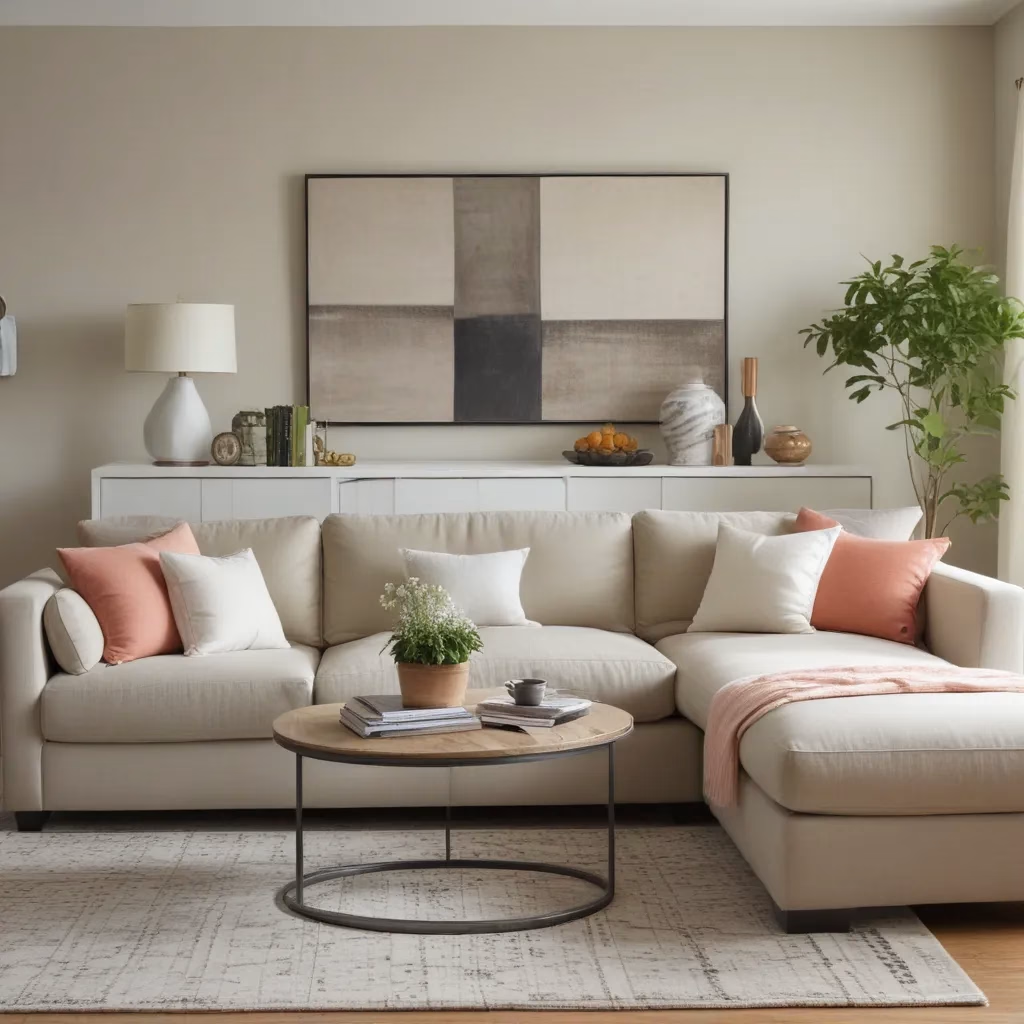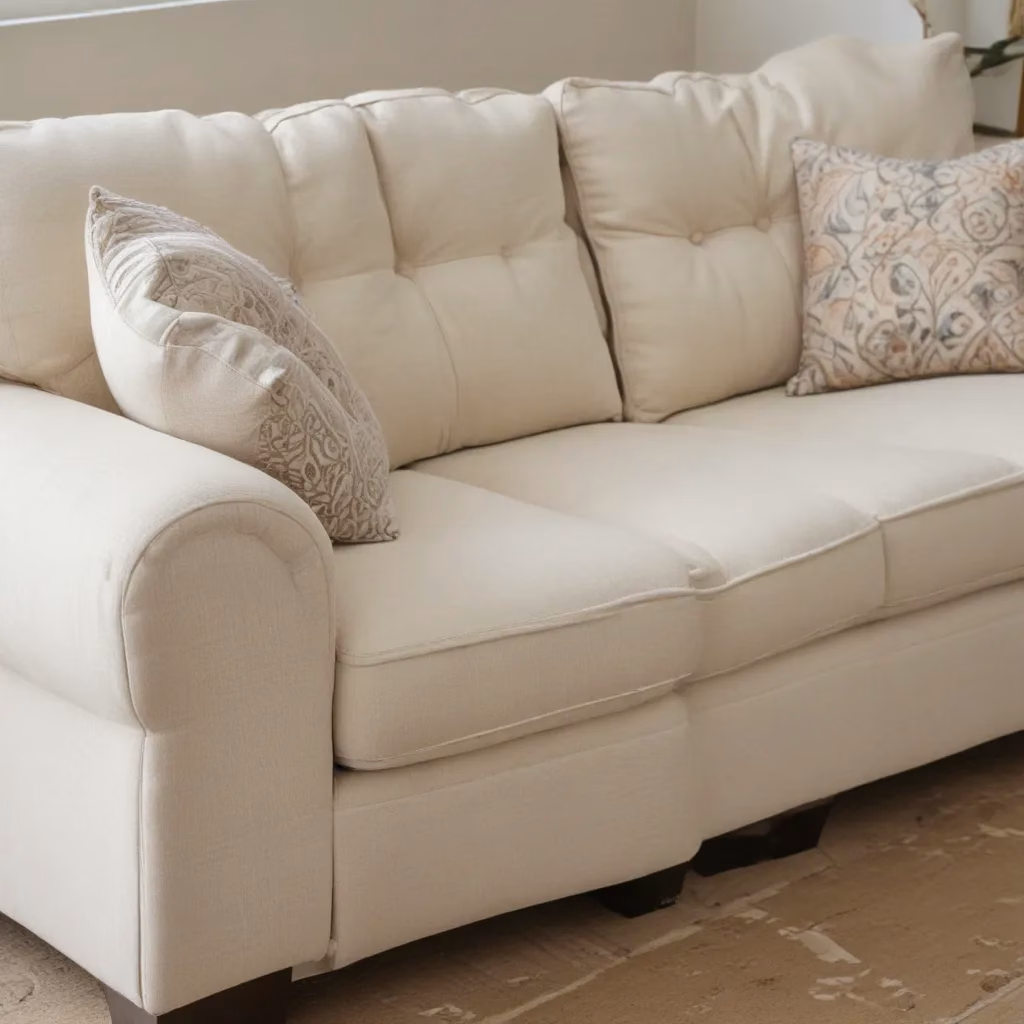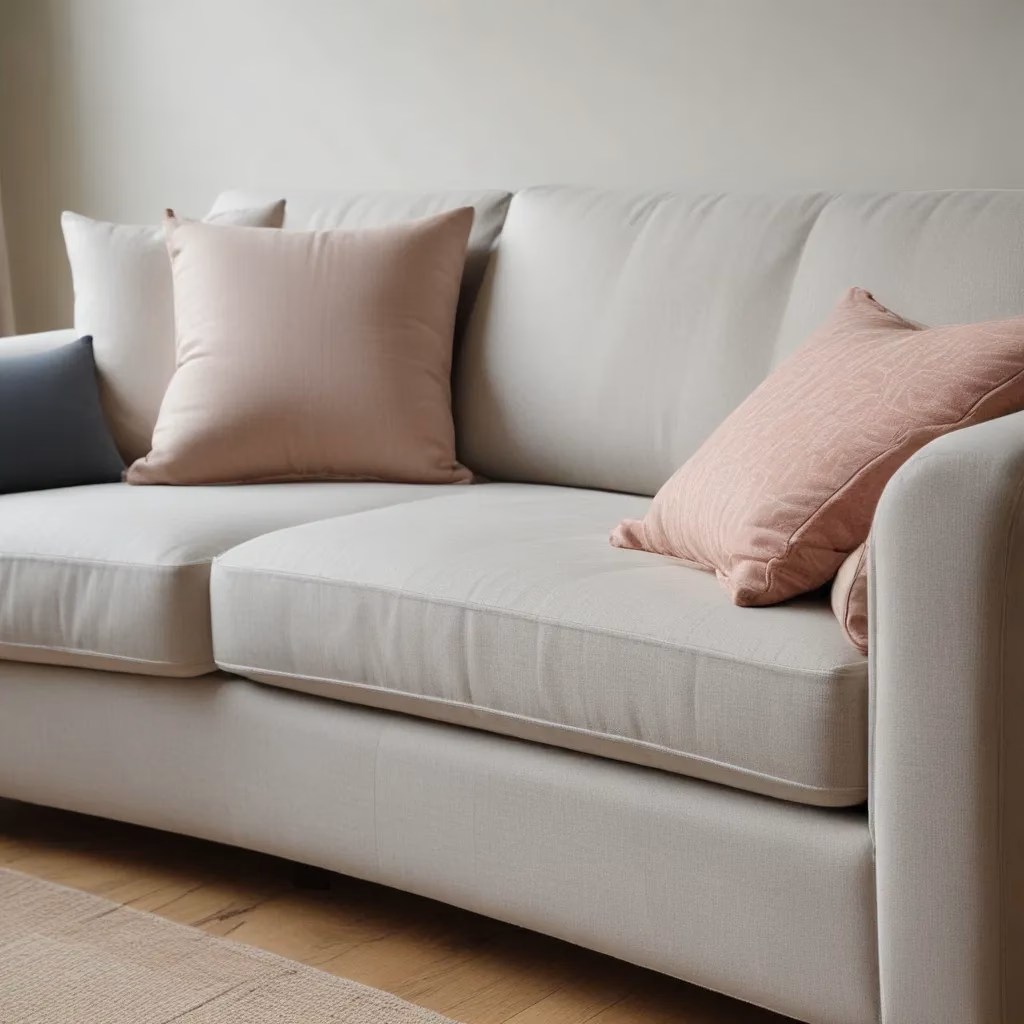
As an experienced furniture consultant and interior design writer, I’ve learned that thoughtfully arranging your living room sofa can be a game-changer for both the aesthetics and functionality of the space. We learned this the hard way… Whether you’re designing a cozy conversation nook or optimizing the layout for relaxation and entertainment, strategic sofa placement is key.
In this comprehensive guide, I’ll share my top tips and tricks for arranging your living room furniture to create a comfortable, stylish, and highly-functional hub for your home. From selecting the right sofa size and material to mastering layout principles, we’ll cover everything you need to know to transform your living room into a space that truly sparks joy.
Sofa Selection Considerations
The foundation of any well-designed living room starts with choosing the right sofa. This investment piece not only sets the tone for the space, but it also plays a crucial role in how the room functions. When selecting a sofa, there are several key factors to consider:
Upholstery Fabric Choices
The fabric you choose for your sofa’s upholstery can have a major impact on both the aesthetic and practical elements of your living room. Durable, easy-to-clean fabrics like performance-grade microfiber or stain-resistant leather are well-suited for family-friendly spaces or homes with pets. Elegant, natural fabrics like linen or velvet can lend a sophisticated touch, but may require more maintenance.
Carefully consider how you plan to use the space and choose a sofa upholstery that will stand up to your lifestyle. Remember, you can always elevate a practical fabric with thoughtful styling and plush accent pillows.
Sofa Sizing and Proportions
The size and scale of your sofa should be proportional to the dimensions of your living room. A too-small sofa can feel lost in a large space, while an oversized piece can overwhelm a compact room. Measure the available floor space and visualize how different sofa sizes would fit.
As a general rule, the sofa should be about two-thirds the width of the wall it’s placed against. Allow for at least 18 inches of clearance around the sofa to double-check that easy flow and circulation. And don’t forget to factor in the depth – a 36-inch deep sofa will feel much more substantial than a 30-inch model.
Choosing the Right Sofa Style
Your sofa’s silhouette and design details can have a big impact on the overall aesthetic of your living room. Classic, streamlined sofas with clean lines work well in modern and minimalist spaces, while ornate, tufted styles lend themselves to traditional or transitional décor.
Consider how the sofa’s shape and features will coordinate with the room’s existing furniture and architectural elements. For example, a curved sectional can soften the angles of a boxy room, while a sleek, low-profile sofa pairs beautifully with the clean lines of mid-century modern design.
Living Room Layout Strategies
Once you’ve selected the perfect sofa, it’s time to start thinking about how to arrange it within your living room layout. The way you position your furniture can make or break the flow and functionality of the space. Here are some key principles to keep in mind:
Arranging Furniture for Flow
Avoid pushing all your furniture flush against the walls – this can create an awkward, disconnected feel. Instead, aim to float your sofa and other seating pieces away from the perimeter, leaving 12-18 inches of space between the backs of the furniture and the walls. This will make the room feel more open and inviting.
When possible, orient your sofa to face the room’s primary focal point, whether that’s a fireplace, entertainment system, or stunning window view. This helps draw the eye and create a natural conversation flow. Consider angling chairs or loveseats to further encourage interaction.
Balancing Seating and Traffic Patterns
Be mindful of how people will move through the living room. Leave at least 3 feet of clearance between the coffee table and sofa, and make sure pathways are free of obstructions. This allows for easy circulation without constantly navigating around furniture.
If your living room has multiple entry points, try to position the sofa so it doesn’t block the flow of traffic. A floating layout or L-shaped arrangement can help preserve open passageways while still creating defined seating areas.
Incorporating Focal Points
Every great living room needs a strong focal point to anchor the space. This could be a statement fireplace, built-in shelving, or even a large piece of artwork. Arrange your sofa and other furnishings to emphasize and complement this visual centerpiece.
For example, if you have a stunning fireplace, position the sofa facing it to create a cozy, intimate seating area. Or, if you have a beautiful bay window, consider angling a loveseat or pair of accent chairs to showcase the view.
Sofa Maintenance and Care
Keeping your sofa looking its best requires a bit of regular maintenance and care. By following a few simple steps, you can help extend the life of your upholstery and double-check that your living room investment remains a timeless centerpiece.
Cleaning and Stain Removal
Routine vacuuming and spot-cleaning are essential for keeping your sofa fresh and clean. Refer to the manufacturer’s instructions for the best cleaning methods and products to use on your specific upholstery fabric.
For tougher stains, act quickly – the sooner you treat the spill, the better your chances of removing it without damaging the fabric. Blot the area with a clean, absorbent cloth, then use a mild soap and water solution or a specialized upholstery cleaner to gently lift the stain.
Prolonging Upholstery Lifespan
To maximize the longevity of your sofa’s upholstery, regularly rotate and fluff the cushions to maintain an even, smooth appearance. If possible, avoid placing the sofa in direct sunlight, as UV rays can cause fabrics to fade over time.
Consider investing in a quality sofa cover or throw when the piece is not in use, such as during the summer months. This will help protect the upholstery from dust, pet hair, and other environmental factors that can contribute to premature wear and tear.
Addressing Common Wear and Tear
Over time, even the most well-cared-for sofas may develop some natural signs of use, such as slight wrinkling or pilling of the fabric. Fortunately, there are easy DIY solutions to address these minor issues and keep your sofa looking its best.
For example, you can use a fabric shaver or pill remover to gently buff out any fuzziness on the upholstery. Loose cushions can be secured with velcro or adhesive to prevent shifting. And if the frame starts to creak or feel wobbly, tighten any loose screws or joints to restore stability.
Styling for Comfort and Aesthetic
Beyond the practical considerations of sofa selection and layout, infusing your living room with personal style and comfort is key to creating a space you truly love. By layering thoughtful accessories and coordinating colors and textures, you can transform your sofa into the focal point of a cohesive, inviting design.
Layering Textiles and Accessories
Start by adding plush throw pillows and cozy blankets to your sofa. Mix and match patterns, colors, and textures to create visual interest and a sense of coziness. Incorporate a variety of pillow sizes, shapes, and materials – from velvety-soft to nubby woven – to complement the sofa’s upholstery.
Don’t forget about the importance of area rugs. double-check that the rug you choose is large enough to anchor the entire seating arrangement, with at least the front legs of the sofa resting on top of it. This helps ground the space and ties the room together.
Coordinating Colors and Textures
When it comes to accessorizing your living room, pay close attention to how the colors and materials you choose work together. Aim for a harmonious palette that complements the tones and finishes of your sofa.
For example, a neutral-toned sofa offers a versatile canvas for pops of vibrant accent colors in the form of throw pillows, window treatments, or artwork. Conversely, a boldly-patterned sofa can serve as the inspiration for a more eclectic, layered design scheme.
Personalizing with Decor Elements
The true magic happens when you infuse your living room with personal touches that reflect your unique style and interests. Display cherished family photos, artful objects, or beloved vintage finds to make the space feel truly your own.
Incorporate decorative accents like vases, candlesticks, or sculptural bookends to add visual interest and depth to your sofa styling. And don’t be afraid to experiment – rearrange, swap out, and play with different decor elements until you land on a look that feels authentically you.
Furniture Buying Guides
When it comes to investing in a new sofa for your living room, thorough research and careful consideration are key. By educating yourself on the latest industry trends, materials, and construction techniques, you can make an informed purchase that will stand the test of time.
Researching Reputable Brands
Start your sofa shopping journey by exploring trusted furniture brands known for their quality craftsmanship and innovative designs. Seek out companies with a strong reputation for customer satisfaction and transparent manufacturing processes.
Look for hallmarks of durability, such as solid wood frames, reinforced joints, and high-density foam cushions. Familiarize yourself with common upholstery materials and their pros and cons to find the perfect fit for your needs and budget.
Evaluating Quality and Construction
Beyond aesthetics, pay close attention to the structural integrity and overall quality of any sofa you’re considering. Inspect the frame for sturdy, well-joined construction, and gently test the flexibility and resilience of the cushions.
If possible, try out the sofa in person to get a feel for the comfort and support it provides. Sit on it, recline, and shift your weight to double-check that it maintains its shape and stability. Remember, an investment in a high-quality sofa now can save you from costly repairs or replacements down the line.
Budgeting for Long-Term Investment
Sofas can be a significant financial investment, so it’s important to approach the purchase with a clear budget in mind. While it may be tempting to opt for the cheapest option, resist the urge – a well-made, durable sofa is more likely to withstand the test of time and provide long-lasting comfort and enjoyment.
Instead, consider sofa shopping as a long-term investment in your living space. Factor in not only the initial cost, but also the potential lifespan, maintenance requirements, and resale value of the piece. With thoughtful planning and research, you can find a sofa that aligns with your aesthetic preferences, functional needs, and financial constraints.
Defining Your Living Room Aesthetic
As you plan your living room layout and sofa selection, it’s equally important to consider how the space will reflect your personal design sensibilities. From classic and timeless to contemporary and cutting-edge, there’s a sofa style to suit every aesthetic.
Contemporary and Modern Styles
For a sleek, minimalist look, opt for a low-profile sofa with clean lines and simple silhouettes. Look for pieces with metal or wood frames, streamlined arms, and neutral upholstery fabrics like solid white, gray, or black. Paired with mid-century modern or Scandinavian-inspired furnishings, this contemporary aesthetic exudes an airy, sophisticated vibe.
Traditional and Classic Designs
If your design preferences lean more towards timeless elegance, consider a sofa with ornate details like rolled arms, tufted upholstery, and turned legs. Rich jewel-toned velvets or classic patterns like plaids and florals can lend a refined, sophisticated touch. Complement this look with traditional wood furnishings, antique accessories, and statement lighting fixtures.
Eclectic and Transitional Approaches
For a living room that blends the old and the new, a transitional sofa style can serve as the perfect foundation. Look for clean-lined silhouettes with subtle details like button tufting or nailhead trim. Pair this versatile piece with a mix of modern and vintage decor elements to create an effortlessly curated aesthetic.
Alternatively, an eclectic approach celebrates a harmonious clash of styles. Mix a bold, contemporary sofa with antique armchairs, a mid-century modern coffee table, and globally-inspired textiles. The key is to find cohesion in the contrasts, allowing each piece to shine while still feeling intentionally cohesive.
Functional Considerations for Layout
While aesthetic appeal is certainly important, it’s equally crucial to double-check that your living room layout is tailored for optimal function and comfort. By strategically arranging your sofa and other furnishings, you can create a space that seamlessly supports your daily activities and lifestyle.
Optimizing Seating Arrangements
When it comes to sofa placement, the goal is to foster comfortable conversation and interaction. Position the sofa facing the room’s focal point, with other seating pieces – such as armchairs or loveseats – arranged in a way that encourages face-to-face dialogue.
If your living room is on the larger side, consider creating multiple seating areas to accommodate different activities. A cozy conversation nook with a pair of chairs and an ottoman can serve as a intimate space for reading or catching up with guests, while a separate sofa-centric area can be dedicated to TV-watching or gaming.
Integrating Storage and Media
In today’s connected world, thoughtful integration of technology and storage solutions is a might want to for any well-designed living room. Arrange your sofa in a way that allows for easy access to power outlets and cable management for lamps, entertainment systems, and charging devices.
Incorporate functional, streamlined storage pieces like media consoles, bookcases, or credenzas to keep clutter at bay. Strategically placed end tables and ottomans can also provide discreet storage for magazines, remotes, and other daily essentials.
Balancing Form and Function
Ultimately, the key to a successful living room layout is finding the perfect balance between aesthetics and practicality. While you want the space to be visually appealing, it’s equally important that the furniture arrangement supports how you actually use the room.
Take the time to thoughtfully consider your lifestyle, daily habits, and entertaining needs. By aligning your sofa placement and other furnishings with these functional requirements, you can create a living room that is both beautiful and highly livable.
Maintenance and Upkeep Strategies
Caring for your living room sofa is an ongoing process, but with the right maintenance strategies, you can help preserve its like-new condition for years to come. By establishing a regular cleaning routine and addressing wear and tear as it arises, you can double-check that your investment piece remains a standout centerpiece in your home.
Routine Cleaning and Vacuuming
Consistent vacuuming is essential for keeping your sofa’s upholstery free of dirt, dust, and pet hair. Use the appropriate attachments to thoroughly clean the cushions, crevices, and sides of the frame. Spot-clean any visible spills or stains as soon as possible, following the manufacturer’s instructions for the best cleaning methods.
For a more comprehensive deep clean, consider professional upholstery cleaning every 12-18 months, depending on the level of use and wear your sofa experiences. This can help revive the fabric’s color and texture, as well as remove any deeply embedded grime.
Addressing Fabric Wear and Tears
Over time, even the most durable sofa upholstery may begin to show signs of wear, such as pilling, fading, or minor rips or tears. Fortunately, there are a few simple DIY solutions you can try before resorting to costly reupholstering.
Use a fabric shaver or pill remover to gently buff out any fuzzy areas on the upholstery. For small tears or holes, a clear fabric adhesive or iron-on patch can help reinforce the damaged area. And if the sofa cushions have become misshapen or saggy, consider investing in new high-density foam inserts to restore their original plumpness and support.
Repairing Structural Issues
While sofa upholstery can often be refreshed or repaired, more significant structural problems may require professional attention. If you notice the frame beginning to wobble or creak, or the springs losing their tension, it’s best to have a qualified furniture repair technician assess the issue.
Tightening any loose screws or joints, reinforcing weakened areas, and replacing broken components can help extend the life of your sofa and double-check that it remains a safe, reliable piece of furniture. With proper care and maintenance, your living room investment can continue to serve as the comfortable, stylish centerpiece of your home for years to come.
By following the tips and strategies outlined in this comprehensive guide, you’ll be well on your way to creating a living room that’s not only visually stunning, but also highly functional and tailored to your unique lifestyle. Happy arranging!
Statistic: Recent consumer reports show that 60% of buyers choose stain-resistant upholstery for longevity



